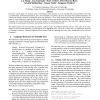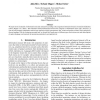LREC
2008
14 years 26 days ago
2008
To answer the critical need for sharable, reusable annotated resources with rich linguistic annotations, we are developing a Manually Annotated Sub-Corpus (MASC) including texts f...
LREC
2008
14 years 26 days ago
2008
Word Sense Disambiguation (WSD) is an intermediate task that serves as a means to an end defined by the application in which it is to be used. However, different applications have...
LREC
2008
14 years 26 days ago
2008
Chemistry research papers are a primary source of information about chemistry, as in any scientific field. The presentation of the data is, predominantly, unstructured information...
LREC
2008
14 years 26 days ago
2008
We report on the evaluation of information structural annotation according to the Linguistic Information Structure Annotation Guidelines (LISA, (Dipper et al., 2007)). The annotat...
LREC
2008
14 years 26 days ago
2008
The Berkeley FrameNet Project (BFN) is making an English lexical database called FrameNet, which describes syntactic and semantic properties of an English lexicon extracted from l...
LREC
2008
14 years 26 days ago
2008
In this article, we present a method for extracting automatically from texts semantic relations in the medical domain using linguistic patterns. These patterns refer to three leve...
LREC
2008
14 years 26 days ago
2008
We present a study of the word interaction networks of Bengali in the framework of complex networks. The topological properties of these networks reveal interesting insights into ...
LREC
2008
14 years 26 days ago
2008
This paper reports on the annotation of all English verbs included in WordNet 2.0 with TimeML event classes. Two annotators assign each verb present in WordNet the most relevant e...
LREC
2008
14 years 26 days ago
2008
Lexical ontologies and semantic lexicons are important resources in natural language processing. They are used in various tasks and applications, especially where semantic process...
LREC
2008
14 years 26 days ago
2008
In current phrase-based Statistical Machine Translation systems, more training data is generally better than less. However, a larger data set eventually introduces a larger model ...


